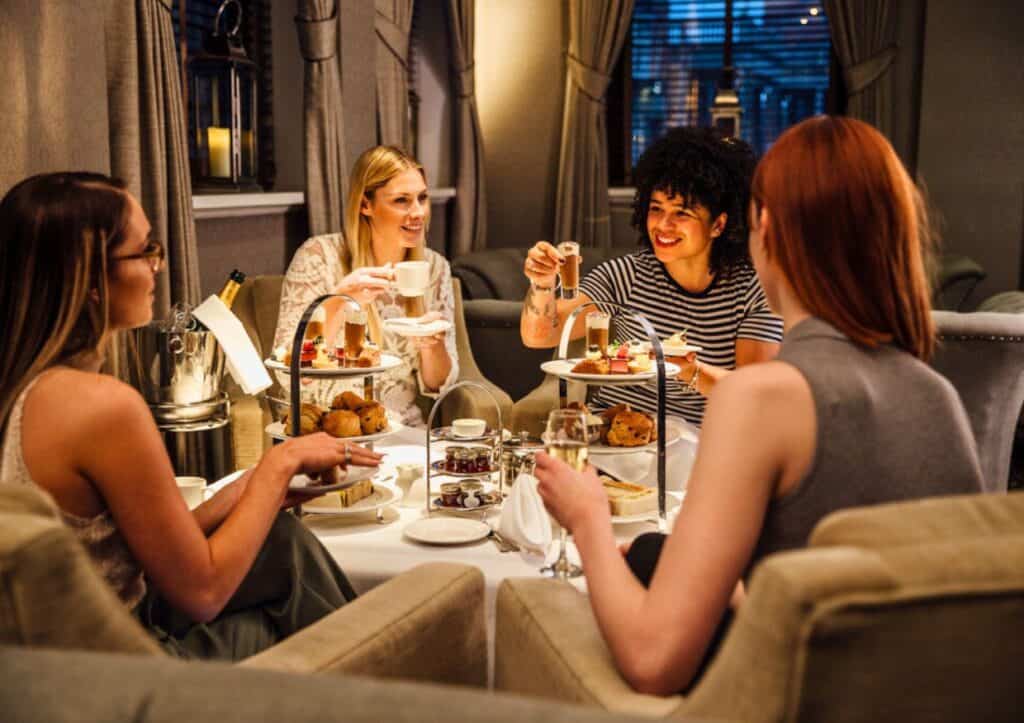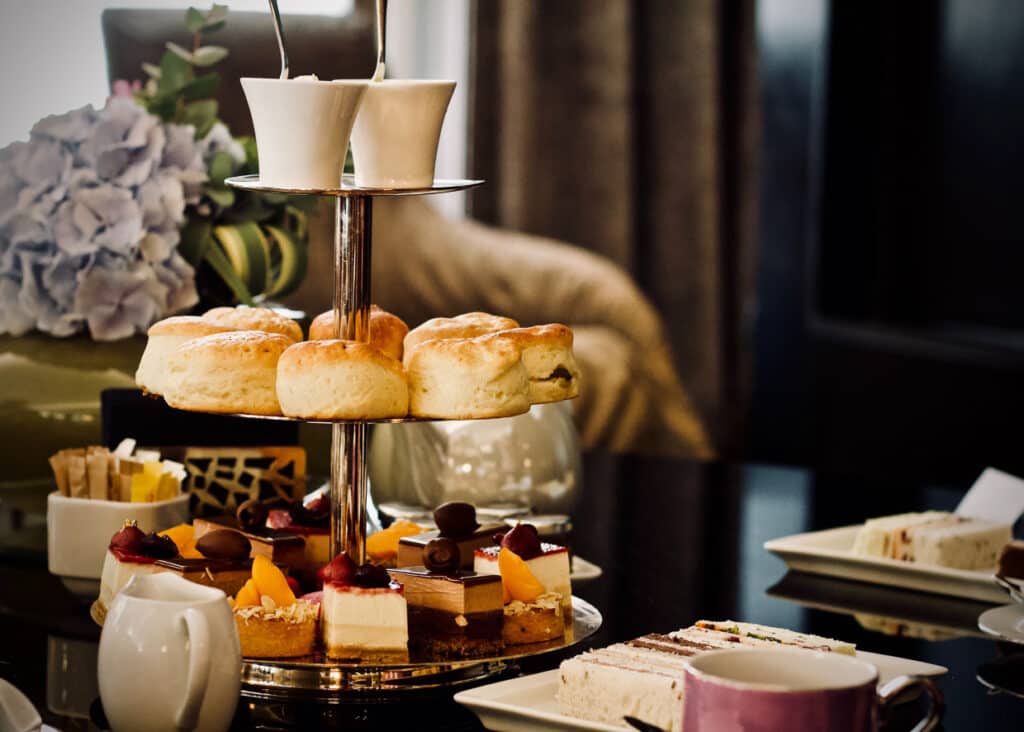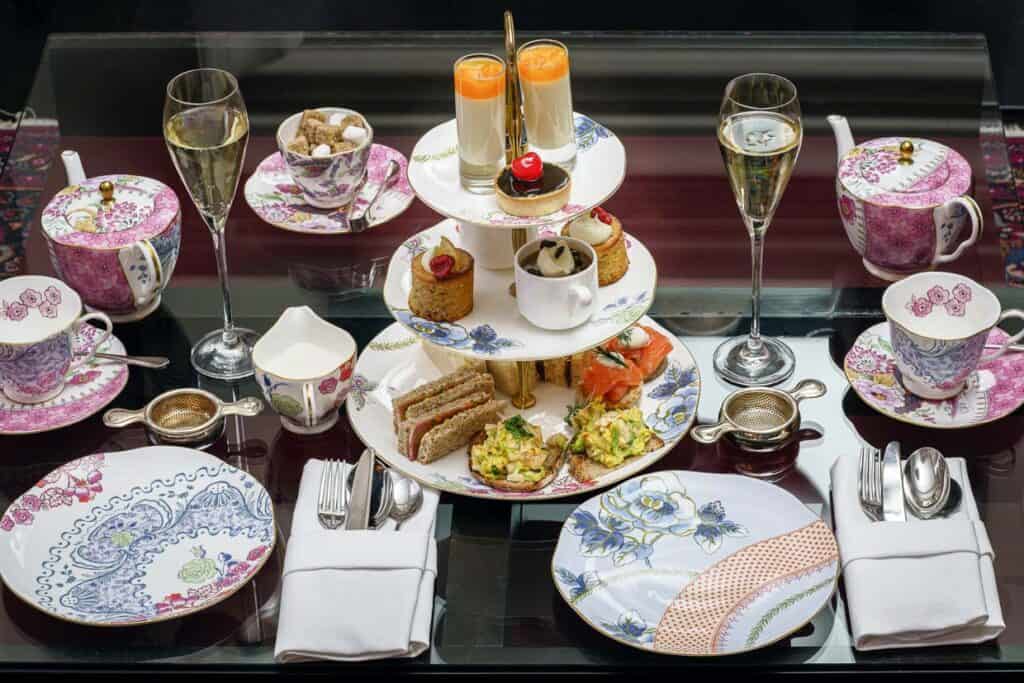English tea is a tradition steeped in history. If you’re new to the delicious afternoon experience, these tea etiquette tips will help you master the art of tea time so you can enjoy this quintessentially British experience.

Growing up, my sister and I often hosted grand tea parties for our stuffed animals. But it wasn’t until I was preparing for my first authentic English afternoon tea that I realized how much I had to learn. Beyond selecting a chic outfit and anticipating tea would be served, I was clueless about what awaited me at this iconic British tradition.
Thanks to a crash course in tea etiquette from my cousin’s English wife, I discovered there was much more to tea time than sipping tea and nibbling on scones. From the art of pouring and stirring tea to some of the finer nuances of this elegant tradition, she prepared me to enjoy the event like a duchess instead of a dork — and I’m eager to share it all with you.
The British tradition of afternoon tea
Afternoon tea is a hallmark of British culture. Born in the 19th century to bridge the gap between lunch and dinner, it quickly became a festive social gathering throughout the nation and the British Empire.
What is afternoon tea?
Tea time is a leisurely affair that brings family and friends together for an afternoon break over a hot cup of tea and an assortment of light bites. The mid-afternoon spread typically features delicate finger sandwiches, freshly baked scones served with clotted cream and jam and bite-sized desserts.
What’s the history of English afternoon tea?
Anna, the Duchess of Bedford, is credited with conjuring up afternoon tea. At a time when two meals a day were the norm and dinner wasn’t served until 9:00 p.m., the close confidante of Queen Victoria would get a bit hangry in the mid-afternoon. The clever duchess devised a novel solution to silence her rumbling tummy: a private tea service in her boudoir accompanied by bread, butter and cake. What began as snacktime for one blossomed into a tea party as the duchess invited friends and family to join her.

Essential etiquette rules for English afternoon tea
As illustrated by how we spell and pronounce certain words, the United Kingdom and the United States are similar but different. Knowing the nuances of afternoon tea etiquette will help you fit in and enjoy your experience with confidence.
Dressing for tea
Most venues serving afternoon tea will anticipate that guests will dress in a smart casual or business casual style. Women can wear dresses or slacks paired with a nice blouse or jacket. Men should wear trousers with a collared shirt. While it’s typically not expected that men wear a coat and tie, adding them can smarten up the look. It is inappropriate to show up for tea in athletic wear, ripped jeans or casual sneakers.
Mind your manners
At afternoon tea, the focus is on the company and the experience. Silence and store your phone so it isn’t a digital distraction. Be sure to keep your phone, purse and any other personal items off the table. Not only is it good table manners, but it provides adequate space for your food and tea and allows you to immerse yourself fully in the moment.
Enjoying your tea
The ritual of tea drinking at these events is as important as the drink itself. As a starter, you’ll want to accept some tea and not a tea. If you don’t want to drink your tea black, add sugar and milk in this order:
- Start with a lump or spoonful of sugar.
- Fill your teacup about three-quarters full.
- Add the desired amount of milk.
To properly stir the sugar and milk into your tea, place your tea spoon in a six o’clock position in the cup and gently move it up and down. Do not stir your tea in a circular motion or make a mini whirlpool in your cup. It is also important not to clink the spoon against the sides or bottom of the cup. As I write this, I hear Julie Andrew’s voice as Mary Poppins says, “Do not clink your spoon, please, Jane. We are not a bull in a china shop!” After completing your vertical stir, set the spoon on the saucer next to the teacup’s back. It should never go in your mouth or remain in the cup.
When it’s time to sip your tea, look into your teacup, not over it. Just like it’s easier to hit a home run when you keep your eye on the ball when pitched, it’s easier not to spill tea down your front or on the tablecloth when you keep your eye on your cup.
As far as pinkies go, forget the etiquette rules my sister and I followed during our childhood tea parties. Extending your pinkie finger is quite rude. Instead, tuck your pinkie finger in and pinch the handle with your thumb, index and middle finger. Take small, quiet sips of tea. If the tea is too hot, let it cool naturally without blowing on it.
Tableware
Afternoon tea is one of the few occasions where it’s perfectly acceptable — even encouraged — to eat with your fingers, especially when it comes to finger sandwiches and other small treats. However, you will need silverware to spread clotted cream and jam on warm scones and dig into some of the desserts.
Once you’ve used a fork or knife, place it on your plate, not back on the table. Be mindful of the secret code your utensils can send out. When you’ve finished your meal, place your fork and knife on your plate at 4:20. If you are still enjoying tea service, rest them at 7:20.
“I love afternoon tea, and my daughter and I are making it a point to try all the nearby places that offer afternoon tea service. She likes the fruit teas, and I like the black teas, so a tea that allows us two pots is ideal. Afternoon tea must be accompanied by a three-tiered stand of goodies. Traditional scones with butter or clotted cream and jam are a must, and any place that offers finger sandwiches on more than just plain bread is our favorite!”
— Jenn Allen, All The Best Spots

Food etiquette
The presentation of treats on a three-tiered stand helps guide the eating order according to afternoon tea etiquette. The bottom level is for savory items, the middle is for scones and the top layer is for sweets.
Savory items typically served at tea include finger sandwiches, pinwheels, mini sausage rolls and other bite-sized offerings. Common sandwich fillings include:
- Thinly sliced cucumbers and butter
- Smoked salmon and dill
- Egg salad
- Deviled ham
- Tuna salad
Moving onto the middle tier, you’ll find the scones. There is a difference between English and American scones, like how English biscuits are cookies while American biscuits are used to make a sandwich or smothered with sausage gravy. British scones are plain, round cakes that resemble American biscuits — minus the sausage gravy). American scones are usually sweet, glazed triangles with mix-ins like blueberries and cranberries.
And under no circumstances should a scone be dipped into your tea like a biscotti or used to make a clotted cream and jam sandwich. Instead, break off a bite-sized piece of the scone, apply clotted cream and jam and enjoy one bite at a time.
The top layer of the serving tray features a variety of sweets, including petits fours, tarts and other desserts. A traditional English afternoon tea sweet is Battenberg cake, a pink and yellow checkered cake wrapped in marzipan.
It’s also important to remember basic table manners like:
- Keep your napkin on your lap while seated at the table.
- Take small bites of food.
- Chew with your mouth closed.
- Finish one bite before taking another.
- Use your napkin to dab your mouth or wipe your fingers instead of licking them.
A parting sip
By following these tea etiquette rules, you not only enhance your own tea experience but also honor a beloved tradition that has charmed tea lovers for generations. Whether you’re enjoying afternoon tea in a quaint English village or a bustling American city, these principles ensure you do so with the grace and poise of royalty.
Sage Scott was bitten by the travel bug as a preschooler when her family moved abroad for the first time. Now settled in America’s Heartland, Sage is a travel writer, world wanderer and photographer whose favorite color is golden hour. Follow her adventures at Everyday Wanderer.
This article originally appeared on Everyday Wanderer.